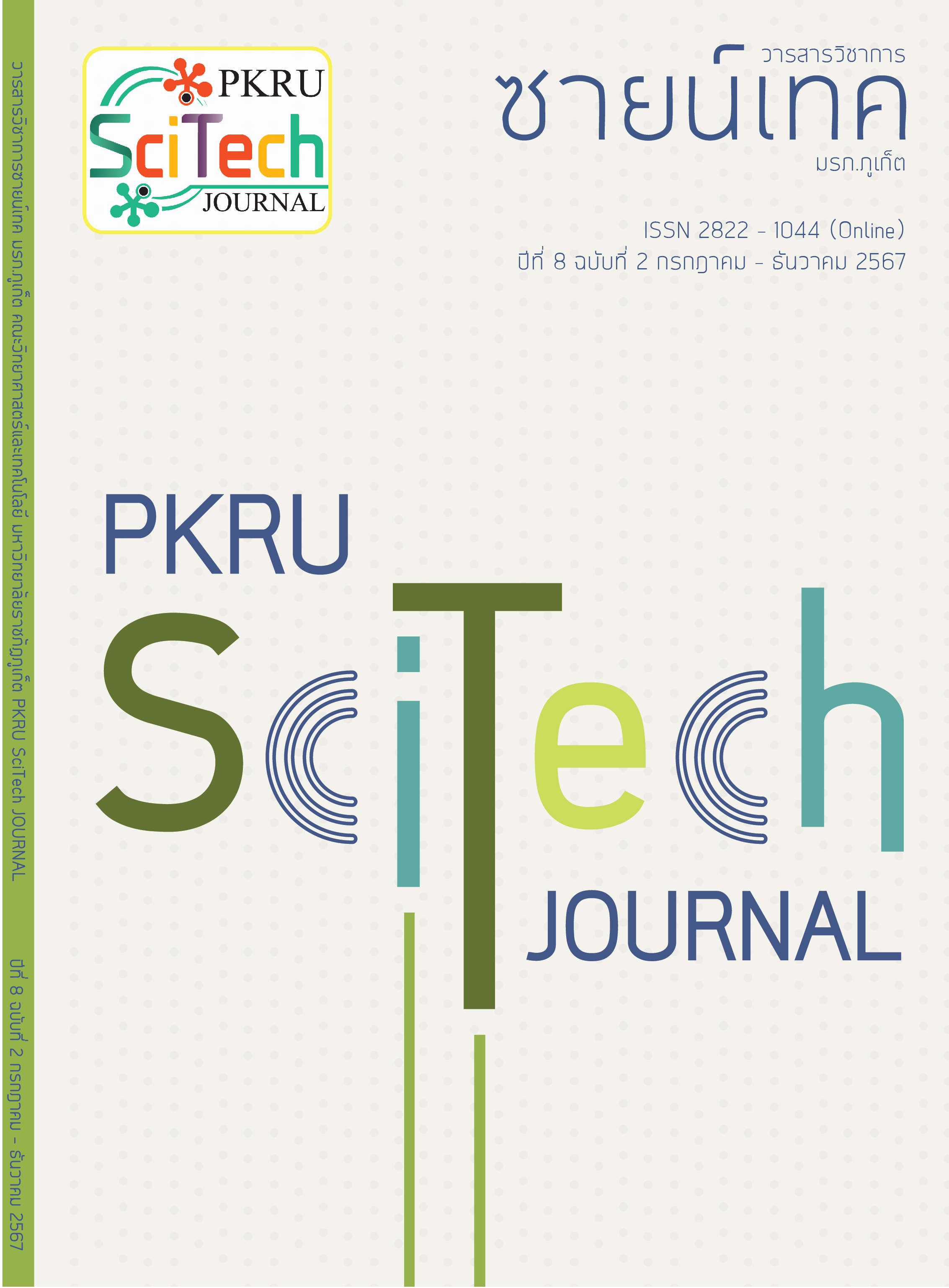A Study of the Quality of Chan Rong Honey Products in Songkhla Province
Main Article Content
Abstract
This study aimed to assess the quality of Chan Rong honey products in Songkhla Province, focusing on honey produced by community enterprises in the region. Our research involved a sample group comprising 25 community enterprises in Songkhla Province. The study encompassed an evaluation of both physical properties and microbial contamination. The results revealed that the pH values of the Chan Rong honey products ranged from 3.21 to 4.45, while the moisture content varied between 14.48% to 20.07%. Microbial contamination was also analyzed, including yeast and mold, Staphylococcus aureus, Salmonella sp., Bacillus cereus, and Clostridium perfringens in honey samples collected from the 25 community enterprise groups. Specifically, the findings indicated that yeast and mold levels ranged from less than 1 colony-forming unit per gram (CFU/g) to 9.0x104 CFU/g. Staphylococcus aureus was detected at less than 1 CFU/g. Bacillus cereus was found in amounts less than 1 CFU/g, and Clostridium perfringens was present at levels below 1 CFU/g, while Salmonella sp. was not detected in any of the samples. These research outcomes hold valuable insights for enhancing the capacity of local communities in the development of high-quality, safe Chan Rong honey for consumers.
Article Details

This work is licensed under a Creative Commons Attribution-NonCommercial-NoDerivatives 4.0 International License.
- The original content that appears in this journal is the responsibility of the author excluding any typographical errors.
- The copyright of manuscripts that published in PKRU SciTech Journal is owned by PKRU SciTech Journal.
References
ณัฏฐ์พัชร เถียรวรกานต์. (2560). มารู้จักกับชันโรง: ฐานเรียนรู้ผึ้งชันโรง มหาวิทยาลัยแม่โจ้. [ออนไลน์], สืบค้นจาก http://mjustinglessbee.com/content.php?view=201501211501163qZjwWu (23 กรกฏาคม 2560).
Rao, P.V., K.T. Krishnana, N. Sallehb, & S.H. Gan. (2016). Biological and therapeutic effects of honey produced by honey bees and stingless bees: a comparative review. Revista Brasileira de Farmacognosia, 26, 657–664.
Rasmussen, C., & Cameron, S. A. (2010). Global stingless bee phylogeny supports ancient divergence, vicariance, and long distance dispersal. Biological Journal of Linnean Society, 99, 206–232.
สมนึก บุญเกิด และธนานิธ เสือวรรณศรี. (2544). ผึ้ง แมลงที่มีแต่ให้...?. กรุงเทพฯ: สำนักพิมพ์ มติชน.
Adnan, F., Sadiq, M., & Jehangir, A. (2011). Anti-hyperlipidemic effect of Acacia honey (desi kikar) in cholesterol-diet induced hyperlipidemia in rats. Biomedica, 27, 62–67.
วุฒิพร เสาวคนธ์. (2562). แผนธุรกิจการจำหน่ายผลิตภัณฑ์น้ำผึ้งชันโรง ภายใต้แบรนด์ PEUNG JIEW. การจัดการมหาบัณฑิต สาขาวิชาความเป็นผู้ประกอบการ. มหาวิทยาลัยกรุงเทพ.
อรวรรณ ดวงภักดี, ปรีชา รอดอิ่ม, มนัญญา เพียรเจริญ และ สุภาวดี ชมพูพันธ์. (2553). การศึกษาการเลี้ยงชันโรง เพื่อผลิตน้ำผึ้งสมุนไพรและสารออกฤทธิ์ทางชีวภาพของผลิตภัณฑ์ที่ได้. กรุงเทพฯ: สำนักงานคณะกรรมการวิจัย.
ศนิ จิระสถิตย์. (2560). จุลินทรีย์ก่อโรคในอาหาร. วารสารวิทยาศาสตร์บูรพา, 22(2), 218–232.
Ray, B., & A. Bhunia. (2014). Fundamental Food Microbiology (5th ed). Florida: Taylor & Francis.
Scallan, E., Griffin, P. M., Angulo, F. J., Tauxe, R. V., & Hoekstra, R. M. (2011). Foodborne illness acquired in the United States-unspecified agents. Emerging Infectious Diseases, 17, 16–22.
Khalid, M. I., Chilek, T. Z. T., Ahmad, F., Abd Razak, S. B., & Mohd Amin, A. T. (2019). Bio-risk stingless bee honey: an assessment of microbial air quality surrounding meliponiculture farm with IMA standard at Marang and Kuala Nerus, Terengganu, Malaysia. Asian Journal of Agriculture and Biology, Special Issue, 86–91.
Kalogeraskis, N., Paschli, D., Lekaditis, V., Pandidou, A., Eleftheriadis, K., & Lazaridis, M. (2005). Indoor air quality - bioaerosol measurements in domestic and office premises. Journal of Aerosol Science, 36(5–6), 751–761.
Chen, Q., & Hildermann, L. M. (2009). The effect of human activities on exposure to particulate matter and bioaerosols in residential homes. Environmental Science and Technology, 43(13), 4641–4646.
Snowdon, J. A., & Cliver, D. O. (1996). Microorganisms in honey. International Journal of Food Microbiology, 31, 1–26.
สำนักคุณภาพและความปลอดภัยอาหาร. (2561). เกณฑ์คุณภาพทางจุลชีววิทยาของอาหารและภาชนะสัมผัสอาหาร ฉบับที่ 3. [ออนไลน์], สืบค้นจาก www.moph.go.th (6 กันยายน 2566).
Van der Vorst, M. M., Jamal, W., Rotimi, V. O., & Moosa, A. (2006). Infant botulism due to consumption of contaminated commercially prepared honey. Medical Principles Practice, 15, 456–458.
สำนักงานมาตรฐานสินค้าเกษตรและอาหารแห่งชาติ. (2557). มาตรฐานสินค้าเกษตร มกษ. 8003-2556. [ออนไลน์], สืบค้นจาก www.acfs.go.th/standard/downlosd/honey.pdf (6 กันยายน 2566).
Chuttong, B.,Chanbang, Y., Sringarm, K., & Burgett, M. (2016). Physicochemical profiles of stingless bee (Apidae: Meliponini) honey from South East Asia (Thailand). Food Chemistry, 192, 149–155.
Keng, C. B., Haron, H., Talib, R. A., Subramaniam, P. (2017). Physical properties, antioxidant content and anti-oxidative activities of Malaysian stingless kelulut (Trigona spp.) honey. Journal of Agricultural Science, 9(13), 32–40.
สมนึก บุญเกิด. (ม.ป.ป). คู่มือการเพาะเลี้ยงผึ้งชันโรง(ผึ้งจิ๋ว), ม.ป.ท.
Shamsudin, S., Selamat, J., Sanny, M., Bahari, A. R. S., Jambari, N. N., & Khatib, A. (2019). A comparative characterization of physicochemical and antioxidants properties of processed Heterotrigona itama honey from different origins and classification by chemometrics analysis. Molecules, 24(3898), 1–20.
Nascimento, A., Marchini, L., Carvalho, C., Araújo, D., Olinda, R., & Silveira, T. (2015). Physical-chemical parameters of honey of stingless bee (Hymenoptera: Apidae). Chemical Sciences Journal, 7, 139–149.
Anderson, K. E., Sheehan, T. H., Eckholm, B. J., Mott, B. M., & DeGarndi-Hoffman, G. (2011). An emerging paradigm of colony health: microbial balance of the honey bee and hive (Apis mellifera). Insectes Sociaux, 58, 431–444.
Morais, P. B., Calaça, P. S. S. T., & Rosa, C. A. (2013). Microorganisms associated with stingless bees. In Pot-Honey: A Legacy of Stingless Bees. New York: Springer.
Amin, F. A. Z., Sabri, S., Ismail, M., Chan, K. W., Ismail, N., Mohd Esa, N., Mohd Lila, M. A., & Zawawi, N. (2020). Probiotic properties of Bacillus strains isolated from stingless bee (Heterotrigona itama) honey collected across Malaysia. International Journal of Environmental Research and Public Health, 17(1), 278.
Ngalimat, M. S., Raja Abd Rahman, R. N. Z., Yusof, M. T., Syahir, A., & Sabri, S. (2019). Characterisation of bacteria isolated from the stingless bee, Heterotrigona itama, honey, bee bread and propolis. Peer Journal, 7, 1–20.
Promnuan, Y., Kudo, T., & Chantawannakul, P. (2009). Actinomycetes isolated from beehives in Thailand. World Journal of Microbiology and Biotechnology, 25(9), 1685–1689.
Yaacob, S. N. S., Huyop, F., Ibrahim, R. K. R., & Wahab, R. A. (2018). Identification of Lactobacillus spp. and Fructobacillus spp. isolated from fresh Heterotrigona itama honey and their antagonistic activities against clinical pathogenic bacteria. Journal of Apicultural Research, 57(3), 395–405.
Olaitan, P. B., Adeleke, O. E., & Iyabo, O. O. (2007). Honey: a reservoir for microorganisms and an inhibitory. African Health Sciences, 7(3), 159–165.


